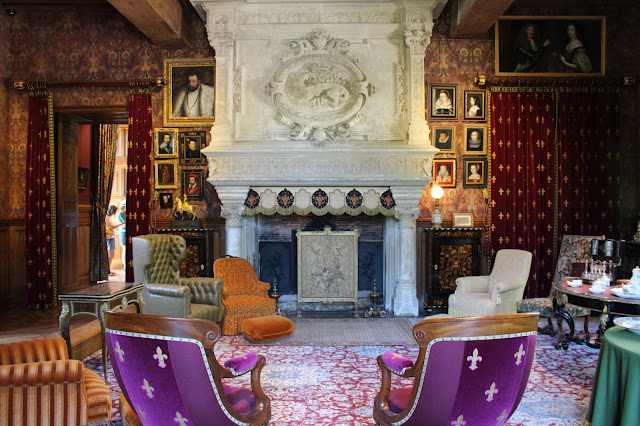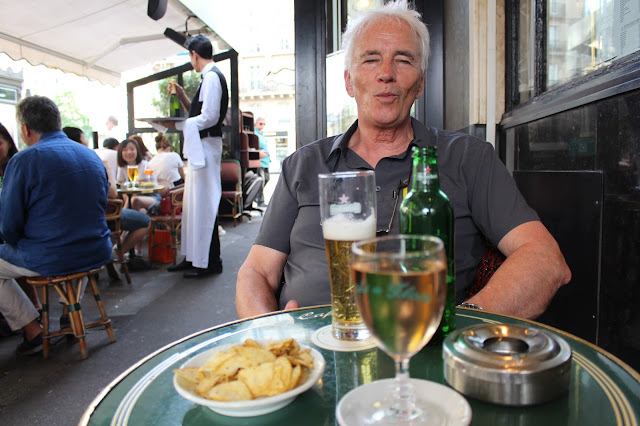Dordogne, Limousin and the Lot are the heart and soul of la belle France, a land of dense oak forests, winding rivers, emerald-green fields and famously rich country cooking. It's the stuff French dreams are made of: turreted château and medieval villages line the riverbanks, wooden-hulled gabarres (traditional flat-bottomed, wooden boats) ply the waterways, and market stalls overflow with pâte, truffles, walnuts, cheeses and fine wines.
Teetering on the crest of a sheer cliff high above the River Lot, minuscule St-Cirqu-Lapopie's terracotta-roofed houses and vertiginous streets tumble down the steep hillside, affording incredible valley views. It's one of the most magical settings in the Lot.
There are certain places in the world you just may remember for your whole life and Rocamadour is one of them. From the dramatic silhouette of Rocamadour's steeples and pale stone chapels clamped to 150m of vertical cliffside beneath the ramparts of a 14th-century château, to the magically evocative feeling as you explore this ancient pilgrimage site, this spot makes an impression.
Pedestrianized Rocamadour climbs the face of a cliff above the River Alzou, ascending from the Cité to the sanctuaries to the château on top. The château is connected to the sanctuaries by the switchbacked, pretty, tree- and cave-lined Chemin de Croix (Stations of the Cross) pathway.
A hugely venerated pilgrimage place through the ages, on holy days as many as 30,000 people would stream into the valley to seek favours from the miraculous statue of the Virgin housed within.
Henry Plantagenet (1139-89), King of England and Count of Anjou, was miraculously cured here. Always an important financial and symbolic spot, Rocamadour suffered during the Wars of Religion when everything was razed. Miraculously, the icon and one bell survived, and they remain today in the rebuilt sanctuaries, which are still an active pilgrimage point.
A colourful 12th century mural of the Annunciation.
And a macabre dance.
Perched atop Rocamadour, the château is a series of 14th century ramparts with excellent views of the valley.
Commanding an unparalleled view across the surrounding countryside from a dizzying outcrop above the Dordogne, Domme was a perfect defensive stronghold—a fact not lost on Phillipe III of France, who founded the town in 1281 as a bastion against the English.

Still one of the area's best preserved bastides, Domme retains most of its 13th century ramparts and three original gateways. The imposing cliff-top position is best appreciated from esplanade de Belvédère and the adjacent promenade de la Barre, which offer panoramic views across the valley.
Domme's perfectly preserved buildings are made from beautiful ochre-coloured limestone.
Figs will soon be ready to harvest.
A picturesque tangle of honey-coloured buildings, alleyways and secret squares make up the beautiful town of Sarlat-la-Canéda. Boasting some of the region's best-preserved medieval architecture, it's a popular base for exploring the Vérzère Valley.

Markets sell a smorgasbord of goose-based products.

La Roque Gageac's row of amber buildings and flourishing gardens built into the cliff-face along the River Dordogne are stunning. And it's an idyllic launch pad for a canoe or gabarres (flat-bottomed boat) cruise.
Towering gloriously atop a limestone bluff, 12th century Château de Beynac's panoramic position above the Dordogne made it a key defensive position during the Hundred Years War. Apart from a brief interlude under Richard the Lionheart, Beynac remained fiercely loyal to the French monarchy, often placing it at odds with the English-controlled stronghold of nearby Castelnaud.
Protected by 200m cliffs, a double wall and double moat, it presented a formidable challenge for would-be attackers, though it saw little direct action.

We're heading out of the Dordogne region now and into the Loire Valley.

The highlight of the 12th century Fontevraud-l'Abbaye complex is the huge but movingly-simple church, notable for its soaring pillars, Romanesque domes and the polychrome stone tombs of four illustrious Plantagenets: Henry II, King of England; his wife, Eleanor of Aquitaine (who retired to Fontevraud following Henry's death); their son Richard the Lionheart; and his brother King John's wife, Isabelle of Angoulème.

The Salle Capitulaire (chapter room), with murals of the Passion of Christ by Thomas Pot.
The cloister is surrounded by what once were dormitories, workrooms and prayer halls.
There's an air of sparkly Parisian sophistication in Saumur but also a sense of laid-back contentment. The food is excellent, the wine even better, the spot is gorgeous—and the Saumurois know it.
Medieval half-timbered houses line the town square.
Soaring above the town's rooftops, Saumur's fairy-tale castle was largely built in the 13th century by Louis XI, and has served as a fortress for protection from the Normans, a Renaissance palace, a Protestant stronghold, an army barracks and now a tourist destination.
Spanning the languid Cher River atop a supremely graceful arched bridge, Château de Chenonceau is one of France's most elegant châteaux.

It's hard not to be moved and exhilarated by the glorious setting, the formal gardens, the magic of the architecture and the château's fascinating history, shaped by a series of powerful women. Let's go inside.
This spectacular complex is largely the work of several remarkable women. The initial phase of construction started in 1515 for Thomas Bohier, a court minister of King Charles VIII, although much of the work and design was actually overseen by his wife, Katherine Briçonnet.
Sandi suspects this incredible ceiling of one of the entry rooms is where Coco Chanel got her inspiration to use interlocked “C's" for her brand's logo.
The château's pièce de résistence is the 60m long, chequerboard-floored Grand Gallerie over the Cher, scene of many an elegant party hosted by Catherine de Médicis and Madame Dupin. It served as an escape route for résistants, Jews and other refugees fleeing from the German-occupied zone (north of the Cher) to the Vichy-controlled zone (south of the river).
The spectacular floral arrangements in the château deserve special mention.
The interior is decorated with rare furnishings and a fabulous art collection that includes an extraordinary portrait of Louis XIV.

Romantic, moat-ringed Château d'Azay-le-Rideau is famed for its elegant turrets, perfectly proportioned windows, delicate stonework and steep slate roofs. Built in the early 1500s on a natural island in the middle of the Indre River, it is one of the Loire's loveliest castles.
Two very different steeples—one Gothic, the other Romanesque—loom above the glorious 13th century cathedral in Chartres.
One of Western civilization's crowning architectural achievements, the 130m long Cathédrale Notre Dame is renowned for its brilliant-blue stained-glass windows and sacred holy veil. Built in the Gothic style during the first quarter of the 13th century to replace a Romanesque cathedral that had been devastated by fire—along with much of the town—in 1194, effective fundraising and donated labour meant construction took only 30 years, resulting in a high degree of architectural unity.
Today, it is France's best-preserved medieval cathedral, having been spared post-medieval modifications, the ravages of war and the Reign of Terror.
After visiting the cathedral we stroll around the carefully preserved town. Adjacent to the cathedral, staircases and steep streets lined with half-timbered medieval houses lead downhill to the narrow western channel of the Eure River, romantically spanned by footbridges.
We've arrived in Paris. Since we've been here before (here and here), we're only staying for three nights, at the charming Odéon Hotel, well-located in the 6th arrondisement, Saint-Germain-des-Prés.

Paris is for walking so we're up early to take in as much as we can.
In 1646 work started on the twin-towered Église St Sulpice, lined inside with 21 side chapels, and it took six architects 150 years to finish. It's famed for its striking Italianate façade with two rows of superimposed columns, its Counter-Reformation-influenced neoclassical decor and its frescoes by Eugène Delacroix.
The fabled 'phantom of the opera' lurked in the opulent Palais Garnier opera house (above) designed in 1860 by the then unknown 35-year-old architect Charles Garnier.
The consummate tourist. Tim is retracing his past as he used to live in Place Vendôme many moons ago when he worked in Paris.
Filled with fountains, ponds and sculptures, the formal 28-hectare Jardin des Tuileries was once the most fashionable spot in Paris for parading about in one's finery. Now, it mainly serves as a wonderful place to rest one's weary feet.
Jardin des Tuileries and the Louvre Museum.

Tim's feeling the romance of Paris and gives Sandi an air-kiss from across the table at Café de Flore, where we pause to wet our whistle. This art-deco landmark hasn't changed much since the days when Jean-Paul Sartre and Simone de Beauvoir essentially set up office here, writing in its warmth during the Nazi occupation.

Whether sophisticated or simple, the French treat plump, shiny white asparagus with esteem, and so do we.
The tiny country village of Giverny, 74km northwest of Paris, is a place of pilgrimage for devotees of impressionism, and can feel swamped by the tour-bus crowd in the summer months. Monet lived here from 1883 until his death in 1926, in a rambling house—surrounded by flower-filled gardens—that's now the immensely popular Maison de Jardins de Claude Monet. His pastel-pink house and Water Lily studio stand on the periphery of the Clos Normand, with it symmetrically laid-out gardens bursting with flowers.
Monet bought the Jardin d'Eau (Water Garden) in 1895 and set about creating his trademark lily pond, as well as the famous Japanese Bridge (since rebuilt).
Monet's charmingly-preserved house and beautiful bloom-filled gardens (rather than his works) are the draws here.
Au revoir Paris! We're off to catch the Eurostar train to London.
















































































